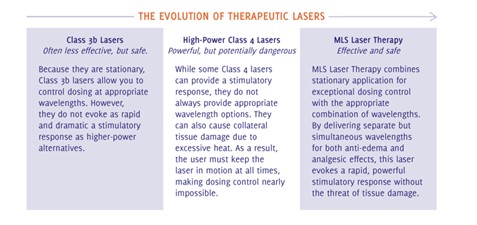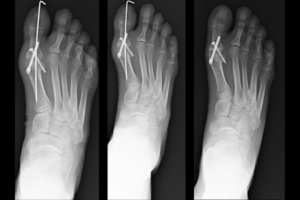From laser pointers to therapeutic and surgical lasers, there are varying types of lasers that have unique characteristics, allowing for a wide variety of applications. The main characteristics that help identify lasers and their effects are:
- Energy: Measured in Joules
- Time: Defined as the duration of irradiance of target tissue and is measured in seconds. It is also known as Impulse Duration or called “impulse width”.
- Wavelength: Penetration depth is directed by the laser emission wavelength and the type of tissue (chromophores).
- Frequency: Defined as the number of impulses emitted during the unit of time (1 second) and should reflect the condition treated.
- Power: Rate at which energy is delivered and is measured in watts.
- Fluence: Energy Density or Dose
- Irradiance (Power Density): Power delivered per unit area
- Emission Mode: Continuous Wave (CW) or Pulsed Wave (PW)
- Impulse Duration: Duration of laser emission, also called “impulse width”.[i]
Regulation
Lasers are subject to the Food and Drug Administration (FDA) Center for Devices and Radiological Health (CDRH) Federal Laser Product Performance Standard (FLPPS) which classifies laser products.[i] The FDA is responsible for protecting public health including ensuring safety of products that emit radiation and medical devices. Lasers can fall into the category of both medical devices and products that emit radiation and therefore are regulated by the FDA.[ii]
The FDA places both medical and non-medical lasers into four major hazard classes and three subclasses based upon ability to cause harm. The lower the class, the lower the potential of harm. The FDA classifications are comparable to the International Electrotechnical Commission (IEC) classifications.[iii]
Class I Lasers are considered non-hazardous, and Class IV Laser are considered potentially hazardous.[iv] As the laser classification increases, the average power input and hazard risk increases. [v] With all laser classes, use of an optical aid such as a telescope, magnifier or binoculars can increase the potential for hazard.
Laser Classifications
| FDA Class | Laser Hazard | Product Examples |
|---|---|---|
| I | Potentially non-hazardous | Laser printers, CD players, DVD players |
| II and IIA | Potentially hazardous. Hazard risk increases when the laser is viewed directly for an extended period. | Bar Code Scanners |
| IIIA | Hazardous when viewed directly, laser pointers fall into this class of lasers. | Laser pointers |
| IIIB | Immediate eye hazard when viewed directly and are hazardous to the skin. | Laser light show projectors, Fiber lasers, CO2 lasers, Welding lasers, Medical lasers |
| IV | Some can be a fire hazard. Beams or reflected beams can potentially be a skin and eye hazard | Laser light show projectors, Fiber lasers, CO2 lasers, Welding lasers, Medical lasers |
Therapy Lasers
Laser therapy is often used to reduce pain and inflammation while also stimulating the body’s natural healing processes.[i] Most therapeutic lasers fit into Class IIIB and Class IV. Class IIIB Lasers have lower power and results are limited, achieved slowly and show at the end of a treatment cycle. Class IV Lasers were developed in an attempt to get better results in a shorter time period. The idea behind Class IV Lasers is that higher power equals better results, however there is a risk of thermal damage to tissue if the laser energy is not controlled.[ii] This is where Multiwave Locked System (MLS®) was created, MLS is a Class IV laser that optimizes the safety of a Class IIIB Laser with the efficiency and results of a Class IV Laser.
MLS and Laser Classifications
The MLS Laser Therapy combines and synchronizes two wavelengths, 808nm and 905nm to create anti-inflammatory and analgesic effects. The laser can penetrate 3-5cm deep without generating heat, minimizing the risk of thermal damage associated with Class IV Lasers. MLS Laser Therapy is FDA cleared and treats pain and inflammation associated with various conditions.

References:
[i] “The Science Behind MLS Laser Therapy.” Cutting Edge Laser Technologies. https://celasers.com/laser-therapy-science.
[ii] “Laser Products and Instruments.” U.S. Food and Drug Administration. https://www.fda.gov/radiation-emitting-products/home-business-and-entertainment-products/laser-products-and-instruments#:~:text=The%20FDA%20recognizes%20four%20major,serious%20injury%20if%20used%20improperly ; “Federal Laser Product Performance Standard (FLPPS).” University of Virginia. https://ehs.virginia.edu/Laser-Safety-FLPPS.html.
[iii] “What We Do.” U.S. Food & Drug Administration. https://www.fda.gov/about-fda/what-we-do#:~:text=FDA%20Basics-,FDA%20Mission,and%20products%20that%20emit%20radiation.
[iv] “Laser Products and Instruments.”
[v] “Laser Products and Instruments.”
[vi] “Back to Basics: Understanding the Mechanisms of Laser Therapy.” Cutting Edge Laser Technologies. https://celasers.com/knowledge-center/back-to-basics-understanding-the-mechanisms-of-laser-therapy.
[vii] “5 Benefits of Laser Therapy.” North Suffolk Neurology. Last modified 2021. https://www.northsuffolkneurology.com/blog/5-benefits-of-laser-therapy-24418.html.
[viii] “The Science Behind MLS Laser Therapy.”



